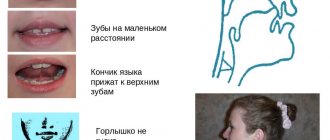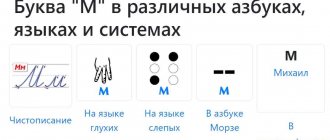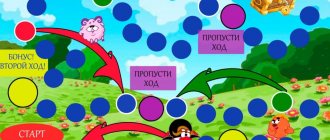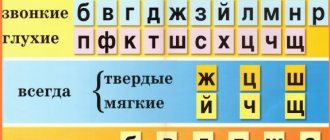В, в - The third letter of all Slavic and most other Cyrillic alphabets. In the Old and Church Slavonic alphabet it is called “vede” or “vedi”. In the Cyrillic alphabet it looks like and has the numerical value 2, in the Glagolitic alphabet it looks like it has the numerical value 3. The Cyrillic form comes from the Greek beta, while the Glagolitic form is usually correlated with the Latin V. Among the styles of the Cyrillic B in manuscripts and printed books, the majority generally retains the general the idea of form, although right up to the typographical italic fonts of the early 19th century, there was an unexpected, at the present glance, lowercase style in the form of a parallelogram, like a printed p, in which the bottom is closed in the same way as the top. In Serbia, sometimes the lowercase b is printed as a Latin letter b.
Examples of words starting with the letter "B"
#WordsWords starting with the letter "B"Wagon, water, wind, bucketWords ending with the letter "B"Anger, pilaf, asset, explosionWith the letter "B" in the middle of the wordTwo, willow, auto, log, primerWords containing several letters "B"Up, platoon, at all, withdrawal, challengeCountriesVatican, Great Britain, Hungary, Vietnam. See all countries starting with the letter “V” Cities Washington, Warsaw, Vienna, Venice, Voronezh. See all cities starting with the letter “B”AnimalsWolf, camel, crow, sparrow, otter. See all animals starting with the letter “V”Vegetables, fruits and berriesCherry, grapes, vanilla.ProfessionsWatchman, veterinarian, driver, diver, vocalist, doctor. See all professions starting with the letter “V” All names starting with the letter “V” with meanings and origins Male names Vitaly, Vladimir, Vyacheslav, Vasily, Vlad. See all male names starting with the letter “B”, as well as their meaning and origin. Female names Valentina, Varvara, Vera, Violetta, Victoria. See all female names starting with the letter “B”, as well as their meaning and originWhat are soft sounds?
To find out what soft sounds are, let’s compare two words and pay attention to the pronunciation of their initial sounds:
"side" and "run"
The first word contains a voiced consonant [b], the formation of which involves the lips:
side [b o k]
The initial consonant sounds quite hard. Compare with the pronunciation of the second word:
run [b' e k]
The first voiced consonant is indicated by the same letter “b”, but it sounds slightly different. When pronouncing it, the back of the tongue rushes towards the hard palate, arching like a bridge. Narrow passages for exhaled air are formed on the sides of the tongue, as a result of which the voiced consonant acquires softness, or palatality. The linguistic term "palatality" comes from the Latin word palatum, which literally means "palate".
So, in Russian speech, hard and soft consonants are distinguished.
Compared to hard consonants, all soft sounds during formation are distinguished by the additional participation of the tongue.
Soft consonants are noisy sounds, in the formation of which there is additional articulation of the tongue to the palate.
The softness of consonants is indicated by a special symbol in the form of a comma - an apostrophe. Speech sounds are written with the corresponding letters in square brackets. The apostrophe is written to the right of the letter denoting a soft sound, at the top:
[b'], [c'], [d'], [d'], [h'].
Study Materials
Poetry
* * * The letter B is carried by a two-humped camel on its back. The one-humped man is offended - the letter B is not visible on him. (S. Ostrovsky)
Poems about the letter "B"
Puzzles
* * * The wolf, the wolf cub and the she-wolf need to learn a little. They don't know at all, that's the problem! What letter did their names begin with? (Letter B)
Riddles about the letter "B"
Tongue Twisters
* * * Baba Vera vinaigrette for Granddaughter Vera for lunch. Together with the letter B, Granddaughter Vera was waiting for them.
Tongue twisters starting with the letter "B"
Fairy tales
Poems about V
Poems are dedicated to different people and events. And we will dedicate today's poems to the letter we met today. Take the baton and come up with your own two- and quatrains. Send them through the comment form. And I will add them to our common collection of poems about V.
*** How good life is for her. In third place in the alphabet. We call it “ve”, and the Greeks call it “vita”.
*** The letter B sits on a branch and shouts from there to Svetka: I will live in your name both at night and during the day.
Sveta smiled and turned away from the letter. “Who the hell are you, naughty letter?”
“I’m not playing with you, I don’t know you. I’ll collect flowers in a bouquet, and who do you look like?”
The letter B is like the number three (3) - Look at it. Everyone knows - Lena, Vita O is the third letter in the alphabet.
Helper fingers
Based on long-term observation of young children, experts have come to the conclusion that the development of fine motor skills keeps pace with the formation of speech skills. Finger exercises activate the parts of the brain that are responsible for speech.
Classes must begin from the first days after birth. And even though the baby is still far from his first words, the massage will well prepare his speech centers for conversation. Finger gymnastics for newborns consists of stroking, bending and straightening the fingers, and circular movements on a small palm.
The nursery rhyme game “Ladushki,” which everyone remembers well from childhood, will teach kids to straighten their fingers and coordinate movements by clapping their hands. Parents recite a funny poem during the game.
At 7 months, when the baby begins to sit, you can introduce him to paper. For example, give the baby an old book with color pictures. Children love to rustle paper, tear off pieces, and crumple it. Parents should take into account that most likely, only scraps will remain from the book.
Games with small objects are great for developing fingers:
- beads;
- cereal;
- buttons;
- peas.
Preschoolers enjoy putting together puzzles, sculpting from plasticine, cutting out paper figures, drawing and coloring pictures.
Words with a dividing hard and soft sign: examples, rules for spelling words
Below are the rules of the Russian language and examples of spelling words with a separating soft sign. This letter "b" is written before:
- "e"
- "e"
- "Yu"
- "I"
- "And"
There are word forms in the Russian language in which the sound “th” . The exception is prefixes; a soft sign is not placed after them (at the root or/and before the ending). After the prefixes there is a dividing solid sign . Here are examples of such words with a separating soft sign:
- Dress
- Snowstorm
- Family
- Foxes
- Serious
A soft sign is also written at the root of borrowed words:
- Medallion
- Senior
After the root there is a soft sign:
- frog skin
- bird's Nest
Below are the rules for spelling words in Russian with a separating solid sign. The separating solid sign is written after the prefix and before the root starting with:
- "e"
- "e"
- "Yu"
- "I"
Examples of words with a hard separator:
- Immense
- Shrink
- Entrance
- Announcement
The letter “Ъ” is written in words ending in a consonant, Latin prefixes: “ab-”, “ad-”, “dis-”, “in-”, “ob-”, “sub-”, “con-” or morphemes-prefixes: “counter-”, “pan-”, “trans-” . Here the prefixes are not distinguished as an independent morpheme, for example:
- Adjutant
- Injection
- Conjecture
- An object
The hard sign can also separate syllables in compound words that begin with "two-", "three-", "four-" . For example: dual-core, trilingual, four-yard and so on.
Finger gymnastics
Speech therapists suggest using fun exercises to develop fine motor skills.
- "Fingers say hello." A simplified version for kids is to connect the thumbs of both hands, then the index fingers, and so on until the little finger. Older children place first the right thumb on the thumb of the left hand, then the index finger, etc. All fingers “meet” under the corresponding poem.
- "Glasses". You can depict an object by connecting your index and ring fingers. The structure is applied to the eyes - and the glasses are ready.
- "Shadow play". The light of a table lamp is directed onto the surface of the wall. An adult shows how to use your fingers to create a shadow on the wall that looks like a hare, a wolf or a flying bird. In the process, you can dream up together with your little fidget.
- "Nest". If there is a toy bird in the house, then it is easy to make a nest for it from your palms. They are folded together in the shape of a boat. Repeat the exercise at least 5 times.
- "Counting book." Performed to a rhythmic count. One - palms lie on the table, two - clench your fists, three - place your palms on the edge. Repeat 5 times.
At one year old, the baby begins to understand the meaning of the words of the adults around him. But its capabilities should not be overestimated. A little person perceives the world, including sounds, through the prism of communication with the older generation. Therefore, it is very important to talk to the baby competently and clearly - then he will develop successfully and speak correctly.
Paired hard and soft consonants
Many voiced and voiceless consonants in the Russian language are distinguished by the sign of hardness/softness and form correlative pairs:
With the help of hard and soft consonants you can distinguish between words:
- rad - row;
- howl - howl;
- son - blue;
- magician - moment.
Several consonant sounds do not have a hard/soft pair. Always hard consonants are the sounds [zh], [sh], [ts]. In any position in a word they sound only firmly:
- fat [f y r]
- silk [s h o l k a v y ']
- citrus [ts y tr rus].
Voiceless and voiced consonants
Consonants are divided into voiced and unvoiced sounds. In this case, voiceless consonants are pronounced with the mouth practically covered and the vocal cords do not work when pronouncing them. Voiced consonants require more air, and the vocal cords work when pronouncing them. That is, voiced consonants consist of noise and voice, and voiceless consonants consist only of noise.
Lifehack for determining the deafness or voicedness of consonants for schoolchildren
To determine whether a sound you encounter is dull or voiced, and children often have difficulty with this, you should cover your ears with your hands and pronounce the sound. When pronouncing dull sounds, they will be heard somewhere in the distance, but when pronouncing voiced sounds, your ears will actually ring! This way you can determine what sound was encountered. Especially during phonetic analysis of words.
Some consonant sounds are similar both in their sound and also in the way they are pronounced. However, such sounds are pronounced with different tonality, that is, either dull or loud. Such sounds are combined in pairs and form a group of paired consonants. There are 6 such pairs in total, each of them has a voiceless and a voiced consonant sound. The remaining consonants are unpaired.
- paired consonants: b-p, v-f, g-k, d-t, z-s, zh-sh.
- unpaired consonants: l, m, n, r, y, c, x, h, shch.
Russian words with a soft sign: examples for memorizing
Rules for spelling a soft sign
From the above, it is clear that the Russian language has many rules with a soft sign. Let's look at one of them, for example. Below you will find the use of the soft sign “b” in words of the rich Russian language, ways of writing it, rules and examples for easy memorization. To better remember the rules about the soft sign, let's repeat it again and look at other examples.
The soft “b” sign, according to the rules, is divided into two groups:
- As an indicator of softness - to indicate the softness of the preceding sound.
- As a separator - an indicator that the following vowels sound like two sounds.
In the first case, according to the spelling rules with a “b” (soft) sign, the following are:
- The soft sign “b” is used at the end and in the middle of words.
- After and before consonants.
- Examples: horse, boy.
In the second case, the spelling rules with a “b” (soft) sign are as follows:
- "b" sign is used in the middle of a word
- After consonants
- Before vowels: - “e”, - “e”, - “i”, - “ya”, - “yu”
- Examples: dress, blizzard, family, serious, fox
At the root of borrowed words:
- Medallion
- Senior
Rules for spelling a soft sign
After a root:
- frog skin
- bird's Nest
For better memorization, you can use special memory poems:
Soft sign, soft sign - You can’t do without it! Without it you cannot write 30, 20, 10, 5.
Instead of 6, we get a pole, Instead of eat, we write eats.
Or...Before E, E, I, Yu, I I stand in the roots, friends. Sparrows, family, housing - in front of Ya, Yu, I, E, Yo.
Summary of speech therapy lesson “Soft sign at the end and in the middle of a word”
This summary is intended for conducting a group lesson with children in grade 3 with a speech conclusion “Systemic underdevelopment of speech.”
The topic of the speech therapy lesson: “Soft sign at the end and in the middle of a word.”
Goals:
Correctional and educational:
- learn to indicate the softness of consonants in writing using the letter ь
- develop the ability to explain spelling
Corrective and developmental:
- develop phonemic awareness and hearing,
- development of general, fine and articulatory motor skills.
Correctional and educational:
- develop the ability to interact with each other,
- cultivate interest in speech therapy classes.
Progress of the speech therapy session:
1. Organizational moment.
Say hello to your guests and smile to everyone around you. Give your hand to the friend on your left and quickly stand in a circle. Now pass the ball to your neighbor on the right. Call your friend by name, and wish him a good day.
2. Rule of speech.
— What do we do in speech therapy classes?
We pronounce the sounds clearly, listen carefully! We read the letters correctly, We write them carefully.
— In order to pronounce all the sounds correctly, let’s do exercises for the tongue.
Articulation gymnastics.
The tongue goes out for a walk, it goes around the house. Who is here and who is there? He looks around. Looks like a comb is combing our teeth. He found himself on a swing, flew up, and went down.
3. Finger gymnastics.
Fingers is a friendly family, They can’t live without each other. Here is the big one, and this is the middle one, the nameless and the last little finger of our little ones. Oh, you forgot your index finger. So that the fingers can live together, we will connect them, and perform the movements.
4. Topic of speech therapy class.
— You will find out the topic of today’s lesson if you guess the riddle:
What letter is it, who knows? Does not indicate sound. It can only show how to read a consonant.
- That's right, this is a soft sign: “b”.
Let's draw a "b" sign Gently with a drop like this. A droplet will soften the letter, the Word will sound softly.
Children write "b" in millet.
— The topic of today’s lesson: “A soft sign at the end and in the middle of a word.”
- What can you say about the soft sign?
- "b" is a letter.
- "b" does not represent any sound.
- "b" can be written, but cannot be read.
— What does the soft sign mean?
It denotes the softness of a consonant.
5. Phonemic awareness.
In the cards, use a counter to cover the consonant that is heard at the end of the word.
Salt, horse, nose, ferret, elk, stump, mosquito, faucet, chalk.
- Remember the words I said.
6. Game “Name the words with a soft sign.”
- Look at the pictures (presentation). Name the pictures in the names of which the consonant sound at the end of the word is pronounced softly.
Elk, horse, rain, carrot, bear, primer, goose, anchor.
- Read all the words. What do all these words have in common?
All words contain a soft sign.
7. Game “Insert a soft sign.”
- Read the words, insert “b” where necessary.
8. Physical exercise (musical).
We worked hard and got a little tired. Get ready guys, dance exercise!
We will clap our hands: Together, more fun. Our feet knocked: It's more fun together. Let's hit you on the knees: Hush, hush, hush. Our hands rise Higher, higher, higher. Our arms began to spin and sank lower. They spun, spun, and stopped.
9. Riddle.
Both boys and girls love us very much in winter, They cut the ice into thin patterns, They don’t want to go home. We are graceful and light, We are curly... (skates)
The word “skates” is posted on the board. The speech therapist reads the word with the children.
- Where is the “b” in the word “skates”?
— Why is there a soft sign after the “N”? (Because "N" sounds soft.)
- Yes, a soft sign can be in the middle of a word.
The soft sign is such a cunning one! In the word he stood in the middle, Letters replaced the feather bed. Between two consonants Feels great.
10. Game “Hide the soft sign in the middle.”
- Change the words so that the soft sign is in the middle of the word.
Horse - skates Stump - stumps Ferret - ferrets
- Where can “b” appear in a word?
11. Working with proposals.
- Read the sentences. What letter is missing in the words?
Los. - a strong beast.. He eats grass and branches, loves salt. Elk were hiding in the thicket of the forest. He has large branched horns
Compose the text following the following sequence:
1) A sentence with a word with “b” at the end. 2) A sentence with a word with a “b” in the middle between the vowels. 3) A sentence with a word with a “b” at the end. 4) A sentence where there are two words with “b”.
- Read the entire text. What have we learned about moose?
- Write out words with a soft sign from the text. Underline the consonant in the words and the soft sign after it.
12. Summary of the lesson.
— When is a soft sign written in words?
— When is a consonant sound pronounced softly?
A soft sign with a consonant is friendly. Needed at the end and middle of a word. We write a sign after the consonants, if we hear them soft.
Homework: learn a poem about a soft sign.
Galimova Galina Pavlovna, teacher-speech therapist, correctional boarding school of the VIII type, Bashkortostan, Yanaul
- Summary of frontal speech therapy lesson “Softening and dividing soft sign”
- Summary of the speech therapy lesson “Automation of the sound [C] at the end of a word”
- Summary of a speech therapy lesson on the topic “Words-objects”
- Summary of a remote speech therapy lesson with a first grade student
- Summary of speech therapy lesson “Related words”
( 2 liked, average score: 5.00 out of 5)
Loading...
![Pronounce (read) syllables with the sound [L_]](https://ls-kstovo.ru/wp-content/uploads/proiznosit-chitat-slogi-so-zvukom-l_-330x140.jpg)







